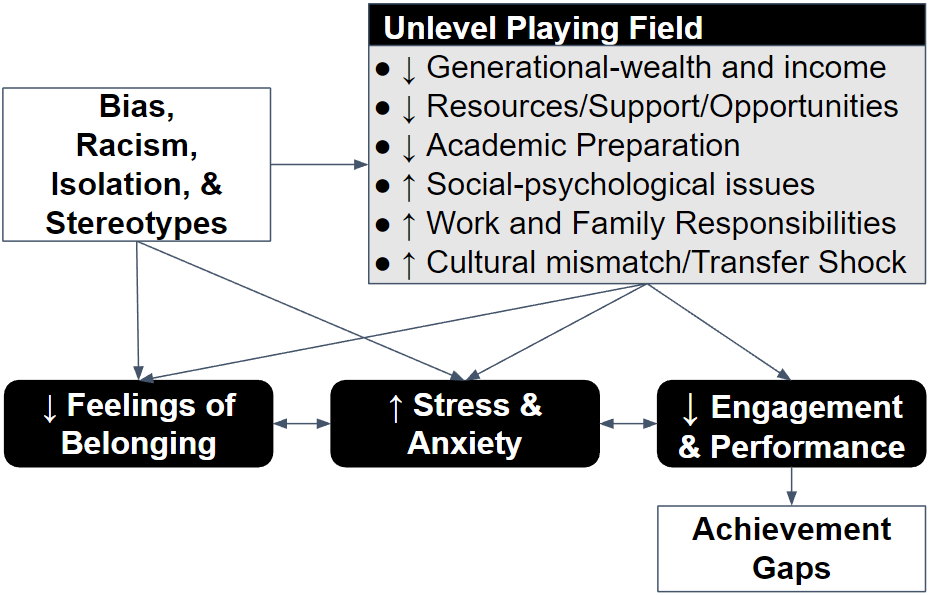Causes of the Achievement Gaps
Many explanations have been proposed to explain the academic achievement gaps seen between AHN and White students, between FG and CG students, and between transfer and non-transfer students. While race and class correlate with the achievement gap data, these attributes by themselves do not suggest a satisfactory explanation for why the disparity exists. Why should it be that a poor student or an AHN student should perform worse on average than a typical affluent or White student? The reasons for achievement gap differences are many, and they are often intersecting and interdependent on each other.
As we will see below, racism and bias contribute to the development of an unlevel playing field experienced by AHN, FG, and transfer students. As mentioned above, these categories are not mutually exclusive and it is common for FG and transfer students to be students of color (Nguyen & Nguyen, 2018; Sansing-Helton et al., 2021). While AHN students experience bias because of the color of their skin, FG and transfer students also experience stereotypes (Croizet & Claire, 1998; Johnson et al., 2011), cultural mismatch (Housel & Harvey, 2010), and/or stigmatization (Chin-Newman & Shaw, 2013; Laanan et al., 2010; Shaw et al., 2019). Bias and racism can then either directly or indirectly lead to the three proximal drivers of the achievement gap: 1) reduced feelings of belongingness, 2) increased stress and anxiety, and 3) decreased engagement and performance (Figure 1). The primary drivers of the achievement gaps as well as their root causes will be further discussed in the paragraphs that follow.

Figure 1. Primary Drivers of Academic Achievement Gaps. Bias, racism, isolation, and stereotypes in college and society contribute to the unlevel playing fields experienced by AHN, FG, and transfer students. The unlevel playing fields between AHN and White students, FG and CG students, and transfer and non-transfer students put AHN, FG, and transfer students at a distinct disadvantage. Bias and racism are the chief cause of the unlevel playing field for AHN students, while cultural mismatch and transfer shock primarily affect FG and transfer students respectively. Reduced generational-wealth and income often leads to fewer resources, less academic preparation, and increased work and family responsibilities. Bias, racism, stereotypes, isolation and unlevel playing fields directly and indirectly cause and exacerbate the three primary drivers of the achievement gap: 1) decreased feelings of belonging, 2) increased stress and anxiety, and 3) decreased engagement and performance.
A widely held belief about a particular group of people.
Difficulties conversing-with and relating-to groups who have norms, experiences, and cultural values that are different from our own.
Public disapproval, shame, and/or unfair treatment due to someone's status as a member of a particular group. For example, there is a lot of stigmatization against those with mental health issues which can make them feel ashamed and decrease the chances that they will seek medical help for their conditions.

